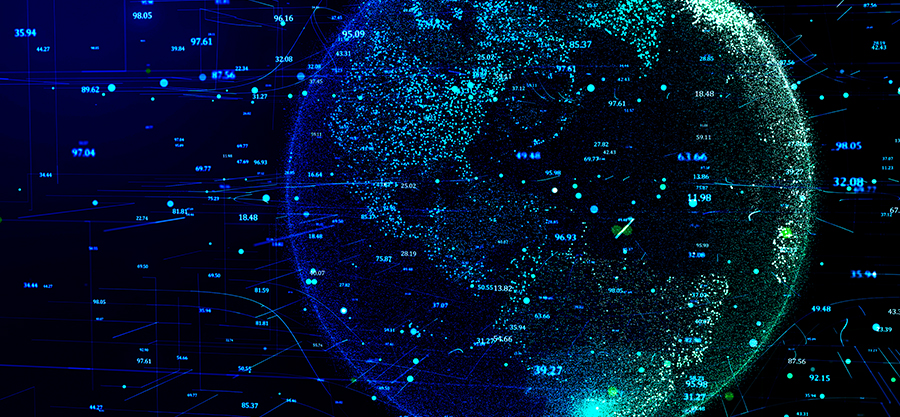Web3 and Decentralized Finance: Building a New Digital Economy?

In a tech industry rife with buzzwords, a new term has been gaining traction over the past year: “Web3.” But what is Web3, why is everyone talking about it, and what implications could it have for financial services in the future?
Definition and Evolution of Web3
Coined by Gavin Wood, co-founder of the Ethereum blockchain, in 2014, Web3 is a loosely defined term that is increasingly being used to describe the next possible iteration of the Internet. Leveraging blockchain, AI/ML, edge computing, and other emerging technologies, Web3 seeks to create a decentralized, open, and intelligent Internet that will provide users with more personalized services while enabling them to once again own and control their data while enabling creators to capture a greater share of the value that they create.
The Internet emerged publicly in the 1990s with Web1. This original iteration was defined by decentralization, open protocols for developers to build on top of, community governance, and one-way information flows from websites to users. Most online activity in this era was skeuomorphic—putting things from the offline world online—and consisted largely of navigating to individual, static web pages through complex directories.
Things began to change in the mid-2000s, as we entered the Web2 era that continues to this day. In Web2, tech giants like Amazon, Google, and Meta built closed protocols and networks on top of Web1’s open protocols. These platforms have enabled users like third-party e-commerce sellers, Youtube video creators, and Instagram influencers to create their own content more easily. However, the Web2 model has also centralized most communication and commerce onto these few dominant platforms, and has allowed the companies that own them to harvest and monetize user data. On the so-called “Social Web,” people can participate freely but the digital landlords capture most of the value they create.
Web3 promises to upend this status quo by replacing Big Tech’s centralized platforms with an Internet in which platforms, apps, content, and data are owned and controlled by individual users, creators and developers, who can capture the lions’ share of that value themselves. In Web3, also known as the “Semantic Web”, machines will be able to better process, manipulate, and make meaningful interpretations of information—combining the decentralization of Web1 with the improved functionality of Web2 to enable everyone to own a piece of the Internet (in theory, at least).
A Future Built on Blockchain
Web3 relies on blockchain technology to guarantee the fidelity and security of transaction records and generate trust without requiring a trusted third party to intervene. In a Web3 world, users will be able to directly interact with each other through open, blockchain-based platforms that they collectively own and operate. These platforms allow builders and users to write and store information by creating “smart contracts”—self-executing contracts whose terms are directly written into the code—and digital “tokens,” mechanisms by which value and control can be given to users, creators and developers. By introducing property rights and decentralization, Web3 could one day serve as the basis for new forms of social and economic activity that allow people to collaborate, create, exchange, and own their digital identities and digital assets.
Most of Web3 today is built on the Ethereum blockchain, though other
blockchains like Solana and
Avalanche
are fast on Ethereum’s heels. Developers have built numerous apps and sites on
Ethereum, including virtual worlds like
The Sandbox and
Decentraland, where users can buy
virtual land, build digital goods and create digital experiences, and
peer-to-peer marketplaces like OpenSea,
where users can trade digital items and collectibles. A thriving
virtual economy powered by non-fungible tokens (NFTs) has emerged in these spaces,
growing
from $95 million in 2020 to $25 billion in 2021. Through Metaverse gateways
like The Sandbox, artists, brands, and other creators are
accessing new revenue streams and engaging with fans in innovative ways
on a global stage.
Web3 and Decentralized Finance
Web3 promises to have disruptive effects across industries, and financial services are not immune. The emergence of Web3-based decentralized finance (DeFi) apps in particular may help solve many pain points of the traditional financial (TradFi) system.
In Web2-based digital finance, traditional banks and some tech platforms serve as trusted middlemen—verifying identity, proof of ownership, and proof of funds while acting as guarantors of transactions. DeFi shifts this role to the blockchain itself, using open protocols secured cryptographically and automated rules encoded through smart contracts to ensure that account balances are accurate and that each party is who they say they are.
DeFi’s long and growing list of use cases currently includes: payments, lending, trading, investments, insurance, and asset management. To provide these financial tools and services, DeFi often leverages “dApps,” open-source applications that come with blockchain functionality and do not belong to a single entity. Examples of dApps include decentralized exchanges (DEXs), borrowing and lending facilities, social media platforms, and marketplaces. dApps can be accessed by anyone with an Internet connection, and companies such as Alchemy and Moralis are making building them as easy as building websites in Web2.
Many feel that Web3 and DeFi offer a second chance to build the open digital economy envisioned by the creators of the Internet. Due to this immense potential, DeFi is rising quickly—since the start of 2020, the total value of assets stored within the global DeFi ecosystem has risen from less than $1 billion to more than $200 billion.
As the ecosystem matures, it is revolutionizing how people engage in digital commerce and financial services. DeFi’s defining characteristics of open, programmable, and composable architecture coupled with permissionless innovation allow for the creation of new financial products and/or the adaptation of TradFi products for Web3/Metaverse. DeFi innovations include:
-
Decentralized Exchanges: The backbone of Web3, DEXs allow
digital asset-holders to profit from appreciation in the value of their
tokens and access other DeFi services at any time without an intermediary.
Uniswap, one of the first DeFi
applications to gain traction, pioneered the
“automated market maker” model
that powers all DEXs by automating the price-matching process.
-
Borrowing and Lending: Loans in DeFi can be backed by
collateral in the form of a digital assets, which are held in smart
contracts and thus do not require credit checks for approval. Some lenders
even accept NFTs as collateral. DeFi credit protocols such as
Compound and
Aave let users instantly lend to or borrow
from a pool of assets, with the interest rate determined by the ratio of
supply to borrowing.
-
Investing in new asset classes: NFTs are
enabling investors to purchase any asset, from virtual art to virtual land.
These investors are
mainly from younger generations, who are increasingly spending time in the Metaverse and usually cannot
afford to invest in physical real estate. The DeFi ecosystem even allows
people to
take out mortgages for virtual property.
To reach their full potential, however, Web3 and DeFi will need to overcome significant challenges. While Web3 promises to improve upon Web2’s privacy and security, making updates to address security problems on Web3 is hard, and no intermediaries exist to provide recourse in the event of cyberattacks. Scalability and transaction fees for blockchain settlement platforms are also constraining factors. In addition, Web3’s high energy usage has raised sustainability concerns—however, many Web3 companies are switching from Ethereum to some of its “forks” that use more environmentally-friendly protocols, such as Polygon. Finally, regulations are a work in progress, as governments around the world attempt to create legal frameworks that reduce risk without stifling innovation within a decentralized global network.
Implications and Opportunities for Financial Institutions
Just as Web3 presents major challenges and opportunities for the tech giants that power Web2, so too does DeFi for the institutions that form the backbone of the TradFi system. To stay competitive, incumbent banks will need to rethink customer journeys around Web3’s seamless convergence of modern technologies and develop more contextualized banking relationships in the Metaverse and beyond. In addition, banks should consider leveraging Web3 technology to reduce costs and reliance on intermediaries in key areas such as payments, loans and credit, trade finance, and customer KYC/AML and fraud prevention.
Finally, to succeed in this new ecosystem traditional banks and even fintechs will need to become comfortable with Web3 experiments and proactively join in. B2B “picks and shovels” software will be key to enabling TradFi companies to operate seamlessly across Web2 and Web3.
Citi Ventures is excited by the companies laying the foundation for an interoperable and secure Web3 future—such as our recent portfolio company TRM Labs, which provides intelligence solutions to detect, monitor, and investigate fraud and financial crime in digital assets across blockchain protocols. By working together, startups and incumbents alike can capture the Web3 opportunity early on and help propel the digital economy envisioned in Web1 to new heights.
For more of Citi Ventures’ thought leadership on blockchain, digital assets, and the Metaverse, click here.

